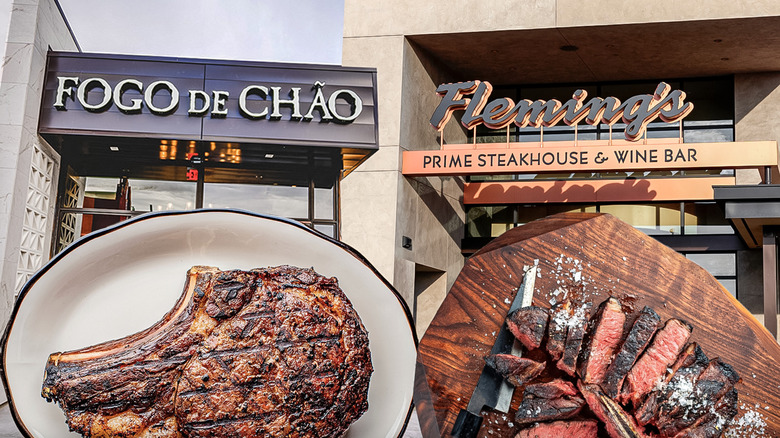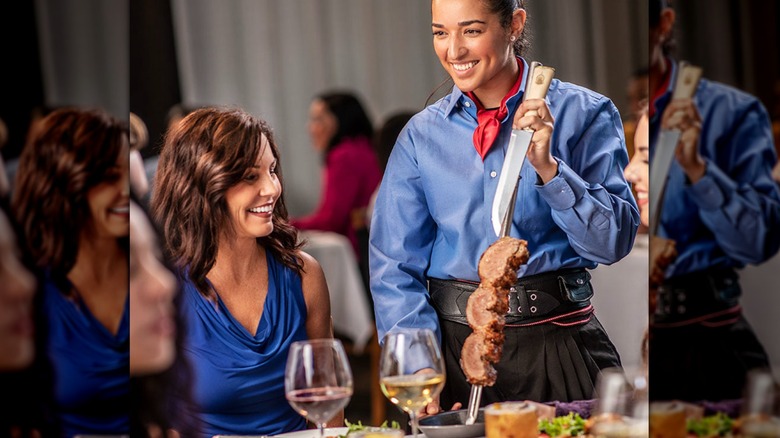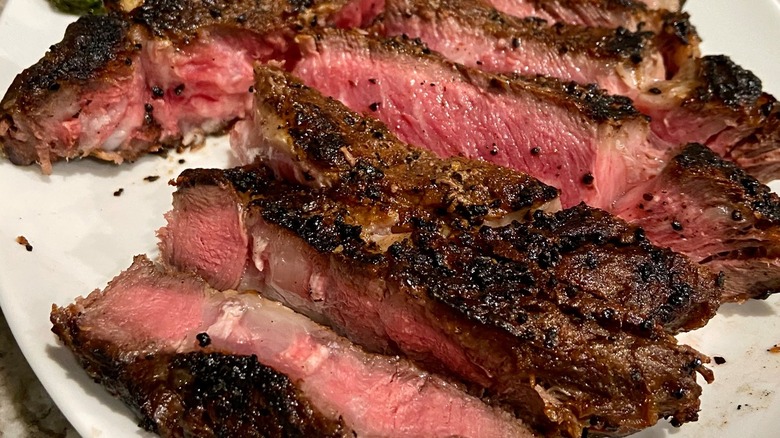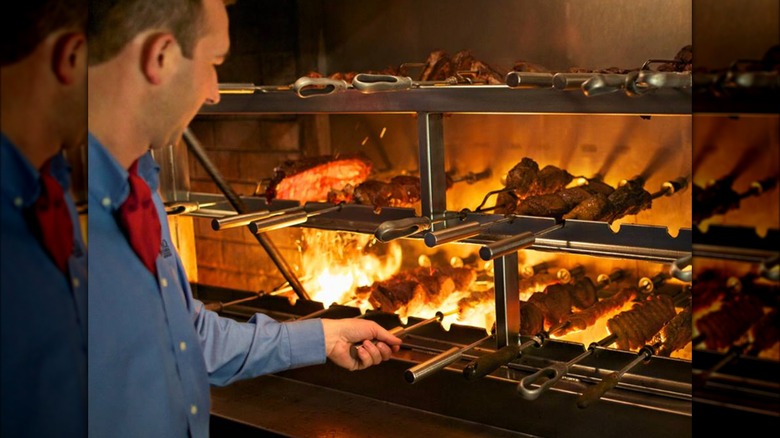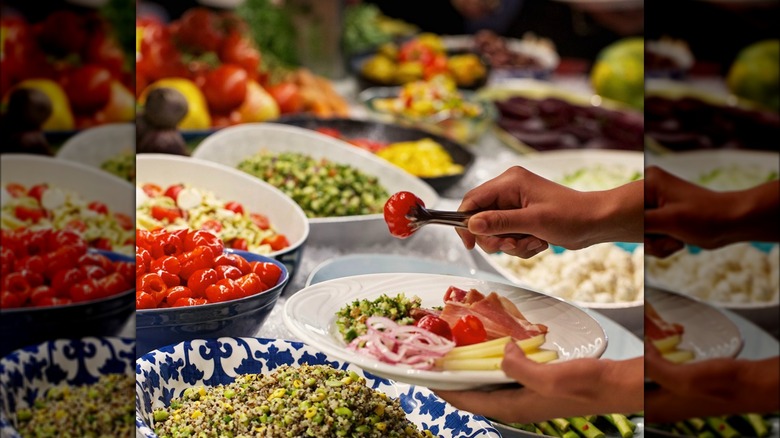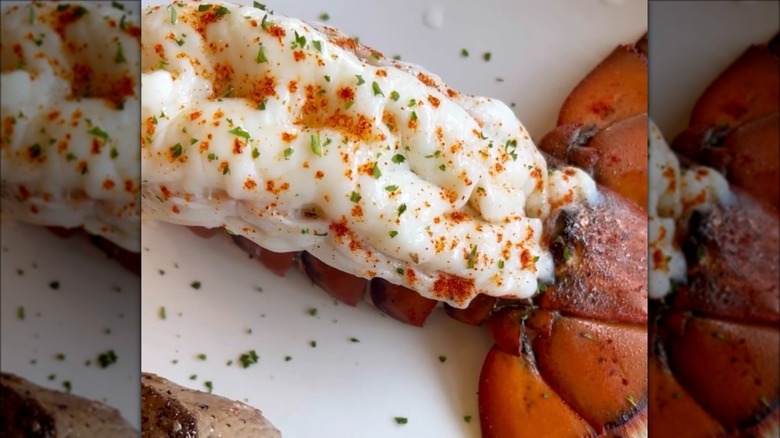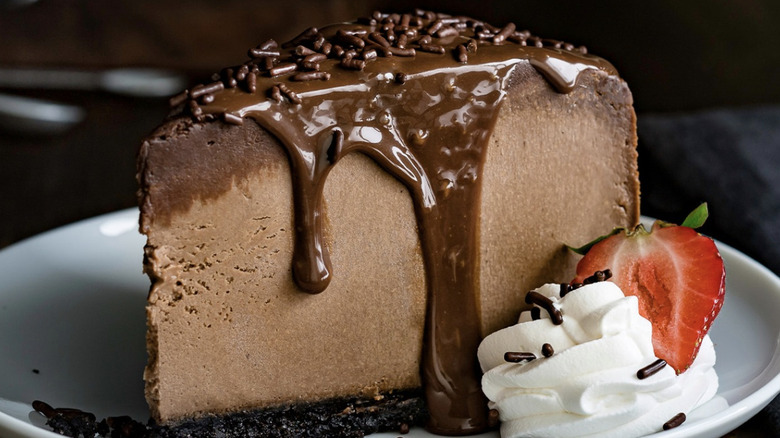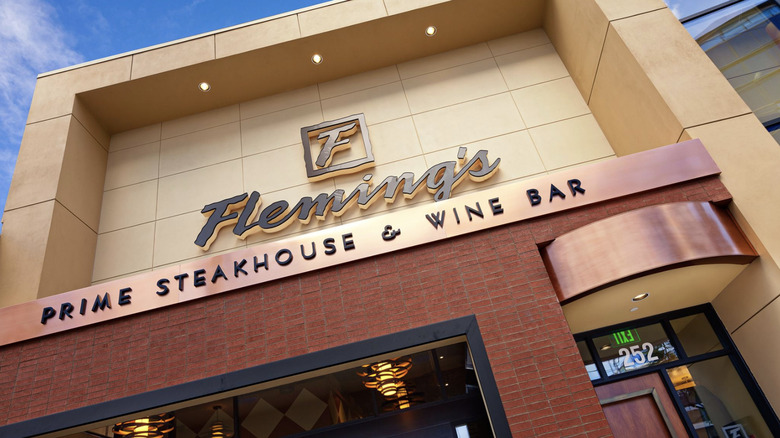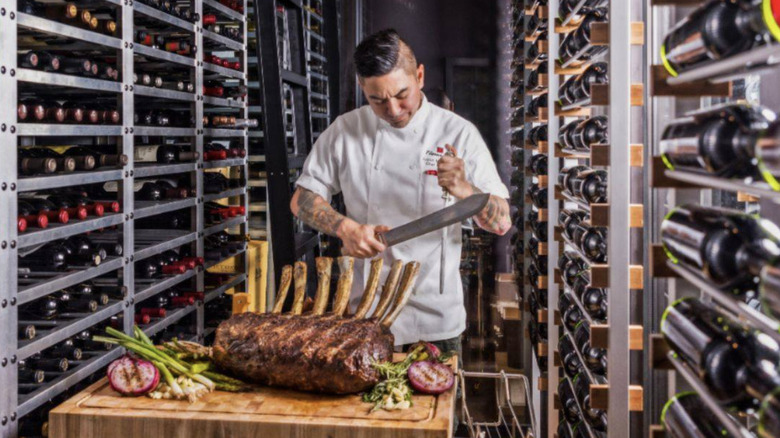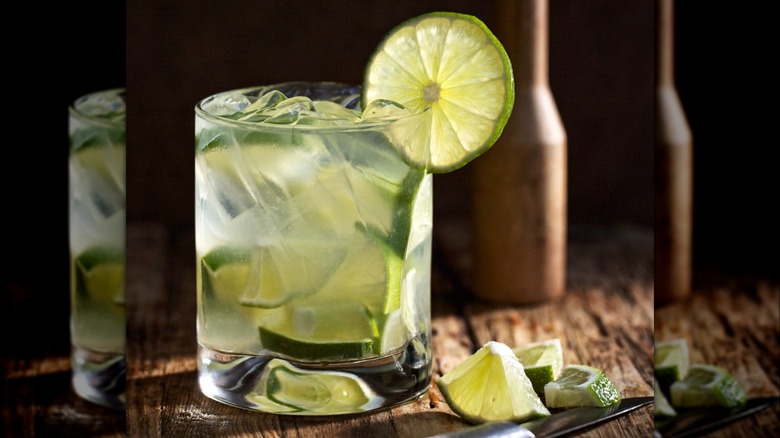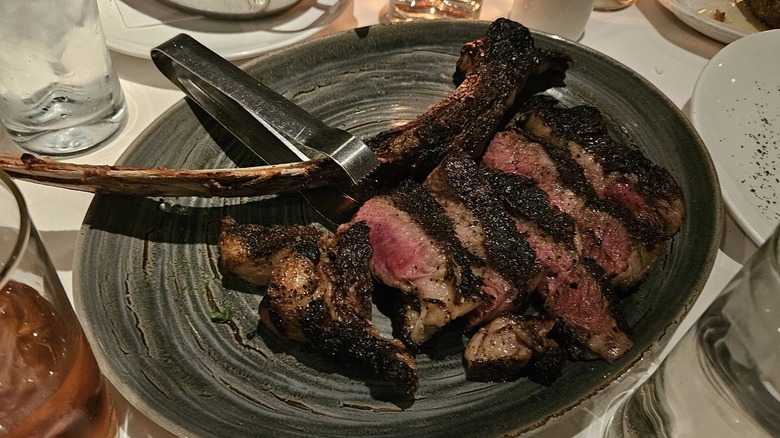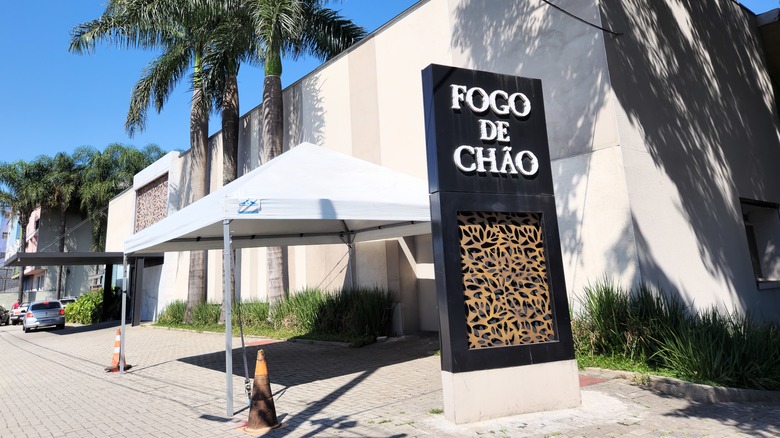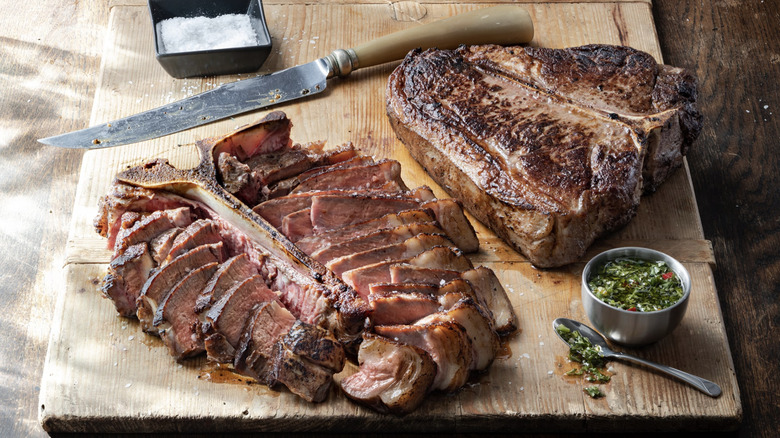Fleming's Vs Fogo De Chão: Which Is Better?
A traditional steakhouse normally evokes images of dark wood paneling, leather upholstery, and dimly lit interiors. However, not all steakhouses conform to this classic picture. Take Fleming's and Fogo de Chão; the former has updated its design concept, moving away from this old-fashioned steakhouse aesthetic to a more modern, bright, and airy design. Meanwhile, Fogo de Chão offers all-you-can-eat churrasco-style dining, where diners engage in an interactive experience that has them choosing their preferred cuts of meat from the restaurant's roaming servers called gauchos.
While pitting two such different restaurants against each other has been tricky, we always embrace challenges head on. After all, we understand that the more information you're armed with, the better your next steakhouse outing is likely to be. Our evaluation of Fleming's and Fogo de Chão takes into consideration numerous factors, from each chain's menu options and food quality to service style. To learn more about our assessment criteria, please take a look at the methodology section at the end of this article.
Fleming's is an American à la carte steakhouse while Fogo de Chão is a Brazilian churrascaria
While both specialize in meat, North American steakhouses and churrascarias are different in their ambiance and the way they serve dishes. Being a contemporary U.S. steakhouse, Fleming's serves its dishes à la carte, with steaks prepared to each diner's exact specifications. In terms of decor, all Fleming's locations are a little different with some overlapping characteristics. Over the past years, the chain has revamped many of its restaurants to bring them in line with current dining trends. Bright and airy, the new look is characterized by elements such as oversized windows, open kitchens, and pops of color.
In contrast, Fogo de Chão is a Brazilian-style churrascaria known for its rodízio service and army of roaming gauchos. Named after South American cowboys, the gauchos circle the restaurant with large skewers of grilled meat. When a patron turns the disc at their table from red to green, the gauchos approach them with a continuous flow of different meats. This means that diners can start their meal right away, rather than wait for their order to be taken and their meal prepared. Fogo de Chão restaurants tend to be lively, with both gauchos and diners constantly on the move. While gauchos attend to the hungry patrons, diners can add to their plates by making trips to the restaurant's all-you-can-eat grazing bar.
Fleming's serves USDA Prime beef while Fogo de Chão offers USDA Choice beef or better
The USDA grades beef into three categories. The top grade is USDA Prime, with only 2% of beef worthy of this designation. USDA Prime beef is known for its rich marbling, which results in tender and flavorful steaks. Next in line is USDA Choice, which is still considered to be of high quality, albeit with less marbling. Finally, USDA Select is the lowest beef grading due to the fact that it's leaner and therefore less tender than the other two grades.
Being an upscale steakhouse, Fleming's prides itself on serving USDA Prime beef. The chain sources its beef from Midwestern cattle that are fed a grain-based diet for at least 200 days. Aside from USDA Prime steaks, Fleming's also serves Certified Angus Beef Ribeye and Japanese A5 Wagyu, both of which are premium choices for those seeking top-tier beef.
Unlike Fleming's, Fogo de Chão isn't open about where it sources its beef. However, the chain's website does specify that all its beef comes from the U.S. Mashed recently spoke with Fogo de Chão's Fort Lauderdale General Manager, Wanderson Oliveira, to get to the bottom of the story. During the interview, Oliveira disclosed that the chain offers USDA Choice beef or better. Fogo de Chão also serves Wagyu beef, including Wagyu New York Strip, Wagyu Ancho (Ribeye), and Dry-Aged Tomahawk Ancho (Ribeye).
The chains use different beef preparation methods
Most of Fleming's beef is wet-aged for at least 21 days to bring out its optimal texture and flavor. The chain only dry-ages one cut — the bone-in ribeye — for a duration of 21 to 30 days to give it a stronger flavor and additional tenderness. Fogo de Chão also specifies that most of its beef is aged for a minimum of 21 days. The exception is one of the restaurant's Wagyu options, the Dry Aged Tomahawk Ancho (Ribeye), which is aged for 42 days.
When it comes to cooking its steaks, Fogo de Chão uses an old-school approach with fire. After all, the churrasco cooking style originated in 16th-century Brazil when gauchos, or cowboys, would grill meat skewers over fire. While things have certainly changed since then, Fogo de Chão still roasts its meat over fire, albeit in a multi-level grill using lumps of charcoal instead of wood.
Fleming's takes a more modern approach by cooking its cuts at 1600-degrees Fahrenheit in a broiler. In addition, the steaks are seasoned with a mix of kosher salt and cracked pepper, and given time to rest before they are delivered to the tables on 350-degree Fahrenheit plates. According to the managing partner of the Coral Gables Fleming's, Zory Mata, there's one additional ingredient that goes into the chain's steaks. "The magic is really in the passion and the love when the chef cooks," they told Coral Gables Magazine in an interview.
Fogo de Chão has an all-you-can-eat market table while Fleming's serves à la carte starters and sides
Available with Fogo de Chão's Churrasco Experience, the Market Table & Feijoada Bar is an all-you-can eat feast of gluten-free starters and sides. Vegetarians can also pay for the Market Table separately. Taking cues from the bustling markets of Brazil, the grazing table features a huge variety of options such as salads, smoked salmon, cured meats, aged cheeses, and antipasti. The salad bar also features fresh seasonal offerings like vine ripened tomatoes, jumbo asparagus, and dragon fruit. Last but not least, Fogo de Chão's market table includes a feijoada bar, featuring the traditional Brazilian black bean stew and accompaniments such as white rice, baked yuca flour with bacon, and malagueta pepper hot sauce.
Diners at Fleming's can choose from an à la carte menu of shareable appetizers and side dishes. Carnivores are welcome to select the chain's Beef Carpaccio, Burrata with Prosciutto, Seared Pork Belly, and Beef Carpaccio. Fleming's also offers a sizzling Japanese A5 Wagyu Strip starter served on a hot stone. The A5 Wagyu grade is the highest designation awarded to Wagyu beef. Fleming's serves plenty of seafood apps including Crab Cakes, Sweet Chili Calamari, and Colossal Shrimp Cocktail. Unfortunately, the chain doesn't excel in the vegetarian department, with the only available non-meat starters being the Signature Onion Rings and Crispy Maitake Mushrooms.
Both chains serve a range of seafood dishes
Fleming's has a lot to offer seafood enthusiasts. Right from the get-go, the chain's starters showcase the restaurant's fresh aquatic options. The star of the show is the Chilled Shellfish Tower. Available in two sizes, the platter includes North Atlantic Lobster, Fresh Oysters, Alaskan Golden King Crab Legs, and Colossal Shrimp. Other seafood apps include Crab Cakes with roasted red pepper & lime butter sauce, Ahi Tuna Poke Stack with caviar, and Sweet Chili Calamari with sweet chili sauce. Meanwhile, in the seafood entree department, Fleming's offers Seared Scallops, Barbecue Salmon Fillet, Miso-Glazed Chilean Sea Bass, North Atlantic Lobster Tails, and Alaskan Golden King Crab Legs.
While Fogo de Chão's seafood repertoire may not be as wide, it's just as appetizing. Served à la carte, the chain's appetizers include a Seafood Tower with Cold Water Lobster Tails and Claws, Snow Crab Legs, Jumbo Shrimp, and Green-Lipped Mussels. Diners looking for individual starter portions can opt for the Jumbo Shrimp Cocktail or Chilled Lobster & Shrimp. All appetizers come with Brazilian malagueta cocktail sauce and a lemon wedge. Fogo de Chão's à la carte entrees also feature a couple of seafood numbers, including Chilean Sea Bass with a papaya vinaigrette and Pan-Seared Salmon with chimichurri.
Fleming's has a children's menu while Fogo de Chão offers discounts for kids
Despite its upscale status, Fleming's welcomes children, with one diner describing their family meal at the restaurant as a "wonderful kid-friendly steakhouse experience." In fact, the chain offers a special Children's 3-Course menu composed of a starter, entree, and dessert. To begin the meal, young diners can choose between a salad or cheese and crackers, and for the final course, they have the option of a fruit bowl or an ice cream sundae. However, the entree menu really shines with options such as chicken tenders, sliders, grilled salmon, and filet mignon.
While Fogo de Chão doesn't have a special menu for children, it does offer discounts for its younger patrons. More specifically, children under six years of age can eat at the restaurant free of charge. Meanwhile, kids between seven and 12 can indulge in the chain's Full Churrasco Experience for half price. In addition, the interactive nature of churrasco-style dining is likely to appeal to families. Far from being stuffy like more traditional steakhouses, Fogo de Chão offers an inclusive environment where kids can get up and venture to select their own food at the market table.
The desserts at Fogo de Chão are more tempting
From rich chocolate cakes to scoops of gelato, desserts can add the proverbial cherry on top of a satisfying meal. There's little doubt that Fogo de Chão recognizes this, offering diners plenty of indulgent options to satisfy their sweet tooth. The chain's lavish lineup of desserts includes a classic Crème Brûlée, as well as a Cheesecake Brûlée torched with caramelized sugar. Fogo de Chão also excels in the chocolate department with a Chocolate Brigadeiro and Chocolate Molten Cake. Rounding up the final courses are Key Lime Pie, Tres Leches Cake, and Papaya Cream crowned with crème de cassis.
While the desserts at Fleming's might not be as mind-blowing as those served at Fogo de Chão, they certainly stand their ground. The restaurant's signature dessert is the Olive Oil Cake, a delectable confection infused with orange and topped with a strawberry wine sauce, balsamic berries, and mint. Meanwhile, chocoholics can indulge in the chain's Chocolate Gooey Brownie with honeycomb brittle or the Chocolate Lava Cake with a molten Belgian chocolate center. Fleming's also serves sweet classics such as New York Cheesecake, Crème Brûlée, and Carrot Cake.
Fleming's and Fogo de Chão have a similar foothold in the US
A lot has happened since Fleming's first opened its doors in Newport Beach, California, in 1998. In the past 26 years, the restaurant has grown to around 65 locations across the U.S. The chain has the biggest footprint in California with 12 restaurants, Florida with nine restaurants, and Texas with seven locations. Meanwhile, the cities with the greatest number of Fleming's steakhouses include Austin and Houston in Texas and Las Vegas in Nevada. The chain used to have an international location in São Paulo, Brazil, but it is now permanently closed.
Having first opened in 1979 in Porto Alegre on the Southern coast of Brazil, Fogo de Chão has a couple more decades under its belt than Fleming's. Despite this, both chains have a similar presence in the U.S., with around 70 Fogo de Chão restaurants across the country. Additionally, there are about 20 international locations worldwide, including in Ecuador, Bolivia, Brazil, Mexico, and the Middle East.
Fleming's has a more extensive wine list by the glass
While both Fleming's and Fogo de Chão feature a lot of wine options by the glass, Fleming's offers around 45 such tipples whereas its competitor only offers 25 single pour vino options. In the past, Fleming's used to pride itself on offering no less than 100 wines by the glass. While this number has shrunk substantially, the chain still offers a solid lineup of whites, reds, and sparkling options. From affordable choices such as Stonecap Estate Chardonnay and Silver Gate Pinot Noir for around $10 per glass, as of publication, to more extravagant options like Post & Beam by Far Niente Cabernet Sauvignon at around $30 a glass, the restaurant caters to most budgets.
Fogo de Chão offers reds, whites, and sparkling wines ranging between $12.25 and $22 per glass. The chain also has a special selection of South American vinos for just $8 a glass. While most of Fogo de Chão U.S. wines come from California, the restaurant also features drops from Washington and Oregon. Additionally, it serves an array of South American wines from Chile and Argentina, as well as a few options from France, Italy, and New Zealand.
Fogo de Chão offers different Caipirinhas while Fleming's serves classic and innovative cocktails
Some of Fogo de Chão's cocktails complement its Brazilian steakhouse theme. For instance, the restaurant serves several types of Caipirinha, an iconic Brazilian cocktail composed of cachaça (a fermented spirit made from sugarcane juice), sugar, and fresh lime. The chain's classic Caipirinha is made with Silver Cachaça or Premium Aged Cachaça and can be flavored with passion fruit or strawberry hibiscus. Finally, just like its name suggests, the restaurant's Mango Habanero Caipirinha contains mango and habanero peppers.
Fleming's serves a diverse range of cocktails, focusing on both traditional favorites and more modern creations. When it comes to classics, the chain delivers The Manhattan with Angel's Envy Rye and Carpano Antica Vermouth, an Old Fashioned with Basil Hayden's Bourbon, and an Artisanal Margarita with Tequila Ocho Plata and Cointreau. Meanwhile, on the more experimental end of the spectrum, Fleming's features concoctions such as the California Jam Jar with Ketel One Vodka, basil, strawberry, and citrus, and the Blueberry Lemon Drop with Tito's Handmade Vodka, blueberries, and candied lemon.
Fleming's is known for its Tomahawk Tuesday promotion
Steakhouse promotions give diners the opportunity to enjoy high-quality cuts of meat at discounted prices. One promotion that has definitely created a buzz — and made upscale dining more accessible to boot — is Fleming's Tomahawk Tuesday. The mid-week special includes a three-course meal for two that features a choice of the chain's bone-in 35-ounce Prime Tomahawk or its Sliced Porterhouse, which consists of a 28-ounce USDA Prime Bone-In New York Strip and a 6-ounce sliced Filet Mignon.
Aside from the entree, diners can select two starters such as Fleming's Salad, Wedge Salad, and Caesar salad. The set-price deal also includes two side dishes like Creamed Spinach, Flash Fried Brussels Sprouts, Chipotle Cheddar Mac & Cheese, and Mashed Potatoes. Finally, patrons can complete their dining experience by choosing from a lineup of desserts that includes New York Cheesecake, Cocolate Lava Cake, and Carrot Cake.
Fogo de Chão is better overall
Other than their penchant for steaks, fresh seafood, and quality wine, there's very little that connects Fleming's and Fogo de Chão. Fleming's is an upscale establishment that serves top-class à la carte steaks and other gourmet creations. Meanwhile, Fogo de Chão is an all-you-can-eat affair that specializes in churrasco-style dining and rodízio service where large skewers are carved tableside by a team of rotating servers. Fogo de Chão also features a grazing table where diners can fill their plates with an array of veggies, salads, cured meats, and cheeses.
Choosing between Fleming 's and Fogo de Chão is a matter of preference and mood. Fogo de Chão provides a more interactive dining experience whereas Fleming's offers a refined setting suitable for those seeking a more traditional steakhouse meal. Nevertheless, after putting both restaurants under a microscope, we believe that Fogo de Chão has the upper hand over its competitor. The chain is more unique, offering a fun culinary escapade that can be enjoyed by the entire family. It also offers a large selection of meat and seafood dishes, as well as an all-you-can eat selection of plant-based dishes bound to satisfy most vegetarians.
Methodology
Comparing Fleming's and Fogo de Chão took a fair amount of research. To give you a better idea about what to expect from each restaurant, we examined several key elements. Firstly, we looked at each chain's ambiance and service style. Next, we considered each establishment's menu options and food quality. Finally, we highlighted the strengths and potential drawbacks of both restaurants by evaluating their additional offerings, such as wines, cocktails, and children's menus.
